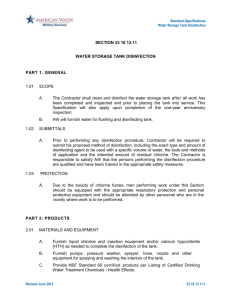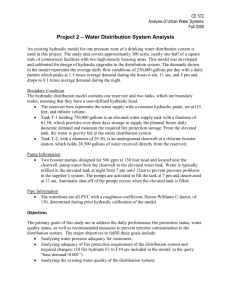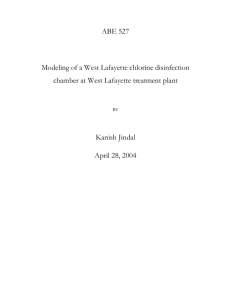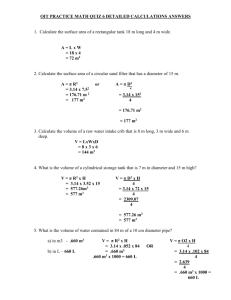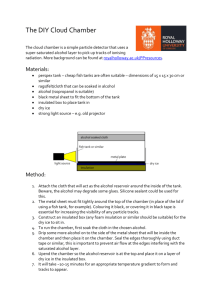Kanish_progress
advertisement
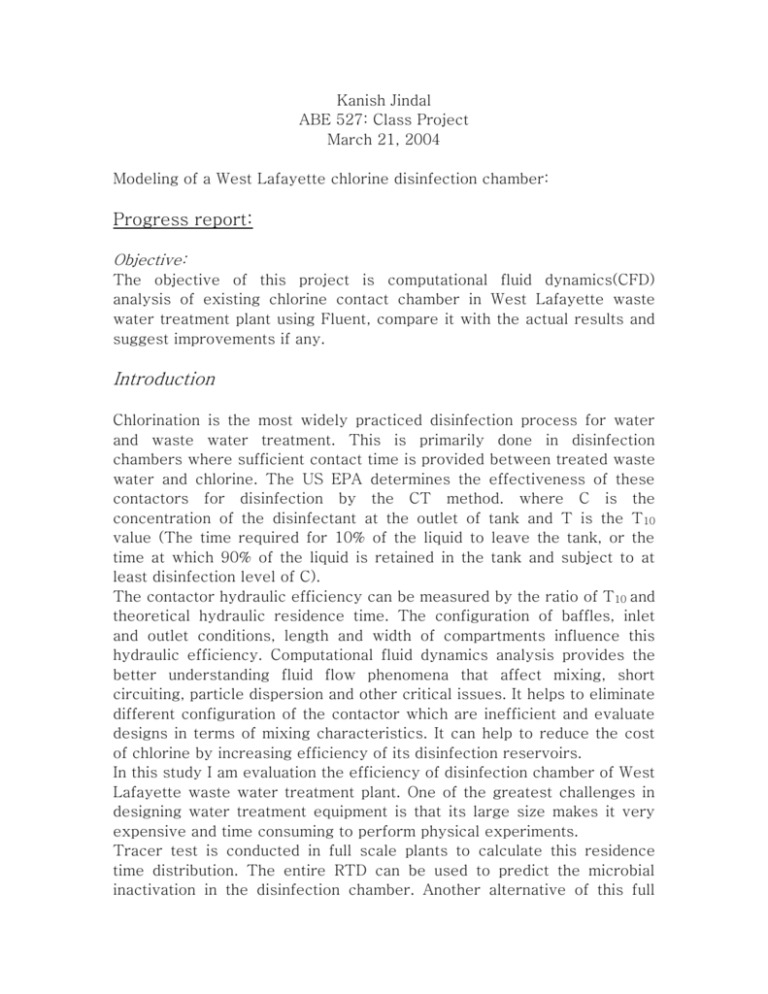
Kanish Jindal ABE 527: Class Project March 21, 2004 Modeling of a West Lafayette chlorine disinfection chamber: Progress report: Objective: The objective of this project is computational fluid dynamics(CFD) analysis of existing chlorine contact chamber in West Lafayette waste water treatment plant using Fluent, compare it with the actual results and suggest improvements if any. Introduction Chlorination is the most widely practiced disinfection process for water and waste water treatment. This is primarily done in disinfection chambers where sufficient contact time is provided between treated waste water and chlorine. The US EPA determines the effectiveness of these contactors for disinfection by the CT method. where C is the concentration of the disinfectant at the outlet of tank and T is the T10 value (The time required for 10% of the liquid to leave the tank, or the time at which 90% of the liquid is retained in the tank and subject to at least disinfection level of C). The contactor hydraulic efficiency can be measured by the ratio of T10 and theoretical hydraulic residence time. The configuration of baffles, inlet and outlet conditions, length and width of compartments influence this hydraulic efficiency. Computational fluid dynamics analysis provides the better understanding fluid flow phenomena that affect mixing, short circuiting, particle dispersion and other critical issues. It helps to eliminate different configuration of the contactor which are inefficient and evaluate designs in terms of mixing characteristics. It can help to reduce the cost of chlorine by increasing efficiency of its disinfection reservoirs. In this study I am evaluation the efficiency of disinfection chamber of West Lafayette waste water treatment plant. One of the greatest challenges in designing water treatment equipment is that its large size makes it very expensive and time consuming to perform physical experiments. Tracer test is conducted in full scale plants to calculate this residence time distribution. The entire RTD can be used to predict the microbial inactivation in the disinfection chamber. Another alternative of this full scale tracer test is to simulate them using CFD models which will thus same time and money. In this research I have modeled chlorine contact chamber of West Lafayette waste treatment plant and predicted its residence time distribution. Experimental Tracer Test: I did the tracer test on actual chlorine disinfection chamber at West Lafayette treatment plant. During the experimental period the flow rate ranged from 7.46-14.63 MGD, and the average flow rate during the experiment was 9.91 MGD (26.06 m3/min). Figure 1 shows that the tracer concentration at time 56min is abnormally high, and it is related as an outlier. The concentration at this point is assumed to be the average concentration of its two neighboring points. The mean residence time can be simplified for a discrete data set as follows: t alli ( t i 1 t i 2 ) ( Fi (t ) Fi 1 (t )) Method for tracer test: In order to determine the Residence time distribution (RTD), fluorescent dye Rhoda mine-wt was added as a pulse(mass=10g) at the influent end of the chlorine contact chamber at WLWWTP. The fluorescent dye provided for the flow visualization or the characteristics of the mixing behavior within the system until the dispersed to the point where it was no longer available. The calculation results are shown in Table 2, and the mean residence time of the chamber is 62.60 minutes. Tracer concentration (ug/l) 40 Data used in calculation original data 35 30 25 20 15 10 5 0 0 10 20 30 40 50 60 70 80 90 100 110 Time (min) Figure 1: Tracer concentration profile of chlorine contact chamber Table 2: Calculation of mean hydraulic residence time at the WWTP Time(min) 50 51 52 53 54 Concentration (μg/l) 0 0.377 0.372 1.3335 7.078 E(t) 0.000 0.001 0.001 0.003 0.018 Corrected E(t) 0.000 0.001 0.001 0.003 0.018 F(t) taveΔF(t) 0.000 0.001 0.002 0.005 0.024 0.000 0.049 0.049 0.180 0.972 55 56 57 58 59 60 61 62 63 64 65 66 67 68 69 70 71 72 73 74 75 76 77 78 79 80 81 82 83 84 85 86 87 88 89 90 91 92 93 94 15.184 19.6553 24.1265 25.7345 29.059 29.611 28.014 26.0755 24.527 23.5835 22.6725 21.0095 17.921 11.3445 9.285 7.4365 7.05 7.156 5.7065 4.33 2.975 2.981 2.47 2.079 1.776 1.577 1.2055 1.1615 0.779 0.678 0.512 0.3885 0.2905 0.364 0.2375 0.173 0.165 0.142 0.1475 0.095 0.040 0.051 0.063 0.067 0.076 0.077 0.073 0.068 0.064 0.061 0.059 0.055 0.047 0.030 0.024 0.019 0.018 0.019 0.015 0.011 0.008 0.008 0.006 0.005 0.005 0.004 0.003 0.003 0.002 0.002 0.001 0.001 0.001 0.001 0.001 0.000 0.000 0.000 0.000 0.000 0.039 0.050 0.062 0.066 0.075 0.076 0.072 0.067 0.063 0.061 0.058 0.054 0.046 0.029 0.024 0.019 0.018 0.018 0.015 0.011 0.008 0.008 0.006 0.005 0.005 0.004 0.003 0.003 0.002 0.002 0.001 0.001 0.001 0.001 0.001 0.000 0.000 0.000 0.000 0.000 0.063 0.113 0.175 0.241 0.316 0.392 0.464 0.530 0.593 0.654 0.712 0.766 0.812 0.841 0.865 0.884 0.902 0.921 0.935 0.946 0.954 0.962 0.968 0.973 0.978 0.982 0.985 0.988 0.990 0.992 0.993 0.994 0.995 0.996 0.996 0.997 0.997 0.998 0.998 0.998 2.125 2.801 3.500 3.799 4.365 4.524 4.351 4.117 3.936 3.845 3.755 3.533 3.060 1.966 1.633 1.327 1.276 1.314 1.062 0.817 0.569 0.578 0.485 0.414 0.358 0.322 0.249 0.243 0.165 0.145 0.111 0.085 0.065 0.082 0.054 0.040 0.038 0.033 0.035 0.023 95 96 97 98 99 100 101 102 103 Sum 0.0915 0.101 0.0595 0.1045 0.072 0.051 0.0655 0.028 0.0265 0.000 0.000 0.000 0.000 0.000 0.000 0.000 0.000 0.000 1.015 0.000 0.000 0.000 0.000 0.000 0.000 0.000 0.000 0.000 0.999 0.999 0.999 0.999 0.999 1.000 1.000 1.000 1.000 0.022 0.025 0.015 0.026 0.018 0.013 0.017 0.007 0.007 62.60 E(t) (min-1) 0.08 0.06 0.04 0.02 0.00 0 10 20 30 40 50 60 70 80 90 10 11 0 0 Time (min) Figure 2: Residence Time Distribution Function E (t ) 26.06m3 / min g 1g 103 l c (t ) 6 10g l 10 g m 3 Corrected E(t)= E(t)/sum(E(t)) F(t) = Cumulative sum of E(t) Sample calculation: At t=52min E (t ) 26.06m3 / min g 1g 103 l 26.06 g 1g 103 l c (t ) 0.372 0.001(min1) 6 3 6 10g l 10 g m 10 l 10 g m3 Corrected E(t=52) = 0.001/1.05 = 0.001 min-1 F(t=52) = F(t=51)+ E(t=52) = 0.01 + 0.01 =0.02 t t52 t t 51 52 taveF (t 52) i 1 i ( F (t i ) F (t i 1)) 51 ( F (t52 ) F (t51)) (0.00192 0.00097) 0.049min 2 2 2 Numerical Tracer test: Fluent follows the following steps for numerical solution: Division of the domain into discrete control volumes using a computational grid. Integration of the governing equations on the individual control volumes to construct algebraic equations for the discrete dependent variables (``unknowns'') such as velocities, pressure, temperature, and conserved scalars. Linearization of the discretized equations and solution of the resultant linear equation system to yield updated values of the dependent variables. Turbulent flow produced in the initial part of the tank is being modeled using the RNG k- Model. The RNG-based k- turbulence model is derived from the instantaneous Navier-Stokes equations, using a mathematical technique called ``renormalization group'' (RNG) methods. The analytical derivation results in a model with constants different from those in the standard k- model, and additional terms and functions in the transport equations for k and . Here k is the turbulent kinetic energy and represents the turbulent energy. Fluent allows you to choose either of two numerical methods: The two numerical methods employ a similar discretization process (finite-volume), but the approach used to linearize and solve the discretized equations is different. Segregated Solution Method: Using this approach, the governing equations are solved sequentially (i.e., segregated from one another). Coupled Solution Method: The coupled solver solves the governing equations of continuity, momentum, and (where appropriate) energy and species transport simultaneously (i.e., coupled together). Governing equations for additional scalars will be solved sequentially (i.e., segregated from one another and from the coupled set. For this project I am using segregated solution method for solving the discretized equations. Although the flow rate varied during the actual tracer test performed at the plant, for the simplicity I am assuming the steady state flow conditions existed in the chamber. Rhoda mine (Inert organic dye) used in the actual experiment has been replaced by liquid water therefore there is no chemical kinetics between the two phases. Steps followed in numerical similitude of disinfection tank: I collected the actual plots or design drawings of the chlorine disinfection tank from treatment plant. I used gambit being a pre-processor for modeling the tank. Tank being rectangular in shape, I used Cartesian coordinate system to define various points on the tank. The modeled was developed from top to bottom i.e. volumes were generated first and nodes, edges and surface The following diagram shows the geometry of the disinfection chamber. The chamber is 41.41 m long in length. The first chamber in the following plot shows the mixing zone. Chlorine is injected at a distance from 14mts from the initial boundary. A hydraulic jump is provided for uniform mixing just below the injection. For the same of simplicity I am assuming there’s turbulent zone for the first few 14 meters in this tank. As a result of this there is uniform mixing of chlorine inside the tank. Plug flow regime occurs beyond this hydraulic jump. Meshing of the fluid volume The following plot depicts the mesh structure of the disinfection tank. Cooper meshing was employed for meshing the whole tank. Inlet and outlet faces were meshed separately to ensure a good mesh density on the boundaries. The following plots show’s an alternate mesh of the structure. Boundary conditions: Appropriate boundary conditions were applied to the tank. The inlet boundary had uniform flux across the whole surface. The inlet velocity as calculated from the flow coming in was used in the negative-x direction. The meshed file is exported as neutral file for the analysis. Analysis of Tank: Processing Fluent is very powerful in modeling fluid flow in disinfection tanks. The solution adaptive grid capability is particularly useful for accurately predicting flow fields in regions with large gradients. The neutral mesh file generated using gambit was imported in fluent. Grid check is applied to see if there’s any error in geometry. The minimum volume obtained came out to be positive. Segregated flow model was used for the analysis under steady state conditions. Water was used as a fluid material with a density of 998.2 kg/m3 and viscosity of 0.001003 kg/(m.sec). For tracking the residence time again water was assumed as an injector. Initially 1000 iterations were carried out. Convergence was achieved after 107 iterations. The following plot shows that convergence was achieved after 107 iterations. The following plot shows the velocity vector of water particles in the chlorine disinfection chamber. It can be seen from the plot that the velocity of particles reaches a very small value at the edges of the reactor resulting in dead zones. The flow regime tends to deviate from plug flow conditions. The following plot is again a contour plot of velocity of particles inside the disinfection chamber. The velocity tends to be more at the center and decreases with distance from center. Similarly the velocity tends to reach very low values on the corners. More analysis is required to depict the actual flow conditions in the tank. There are some issues in terms of flow regimes, boundary conditions and phase interactions which still need to be resolved.

